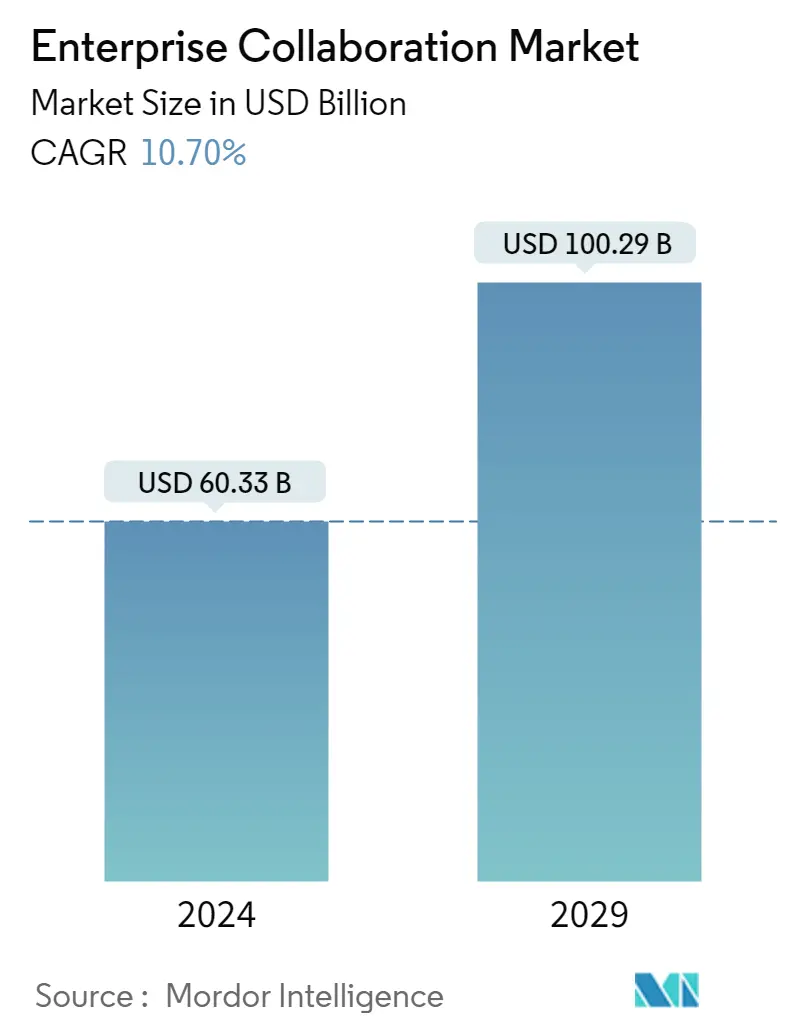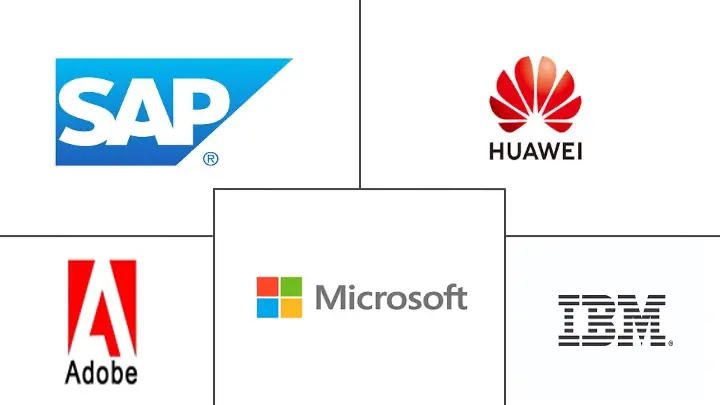Market Size of Enterprise Collaboration Industry

| Study Period | 2019 - 2029 |
| Market Size (2024) | USD 60.33 Billion |
| Market Size (2029) | USD 100.29 Billion |
| CAGR (2024 - 2029) | 10.70 % |
| Fastest Growing Market | Asia Pacific |
| Largest Market | North America |
Major Players
*Disclaimer: Major Players sorted in no particular order |
Need a report that reflects how COVID-19 has impacted this market and its growth?
Enterprise Collaboration Market Analysis
The Enterprise Collaboration Market size is estimated at USD 60.33 billion in 2024, and is expected to reach USD 100.29 billion by 2029, growing at a CAGR of 10.70% during the forecast period (2024-2029).
Enterprises utilize advanced tools like virtual reality, robotic process automation, and artificial intelligence bots to augment internal productivity and promote better employee communication. According to Goldman Sachs, the virtual and augmented reality market's enterprise and public sector segments are expected to account for around USD 16.1 billion by 2025. Virtual reality companies, such as RealSense and DORA, offer immersive experiences for the boardroom.
Enterprise collaboration tools help firms by providing seamless communication between employees and improving their operational efficiency and productivity, helping them meet their business goals. Enterprise collaboration tools provide data synchronization and collaboration solutions across organizations and include features such as checking official emails, calendars, and contacts. Furthermore, video conferencing helps to give the employees more engaging communication and sharing of ideas.
Advanced technologies such as AI, IoT, and ML are being implemented into enterprise collaboration tools to enhance collaborative capabilities. AI-based enterprise collaboration tools can track the activities of employees and the contents being shared and are used to deliver anticipated business insights to the employees and help get the work done quicker by correlating visual analytics with production checkpoints such as consumer behavior, employee retention, office utilization, and performance optimization.
The cloud-based deployment of workloads is anticipated to be primarily driven by the consistent growth in the generated data. Various end-user industries are dealing with a massive volume of data being generated. The data centers are more suited for an organization that has to run many applications and complex workloads for enterprise collaboration. It also enables high productivity, with access to real-time data with all application tools.
For instance, in August 2022, Microsoft announced the launch of its new data center region in Qatar, marking a significant possibility for Microsoft as the most significant hyperscale cloud provider to offer enterprise-grade services in the country. The latest cloud data center region launches with Microsoft Azure and Microsoft 365, giving organizations access to hundreds of scalable, highly available, and resilient cloud services.
The growing usage of mobile devices to operate numerous social networking platforms boosts the enterprise collaboration market growth. It is observed that few people access social networking sites via computers, while most people use smartphones to access these websites. For instance, recently, more than 50% of web traffic in the United States originated from mobile devices, and according to the latest data, mobile internet users in the United States are forecast to reach 300 million by 2026.
Furthermore, emerging economizing, such as China and India, are also experiencing a similar trend, owing to the increasing usage of smartphones due to their easy accessibility. These advantages are propelling the growth of the enterprise collaboration market. According to Ericsson, smartphone mobile network subscriptions worldwide reached almost 6.6 billion in 2022 and are forecast to exceed 7.8 billion by 2028. India, China, and the U.S. have the highest smartphone mobile network subscriptions.
Data privacy concern is one of the significant challenges for the growth of the enterprise collaboration market. While many enterprises focus on preventing malicious data hacking and theft, data breaches are most commonly caused due to lack of data security or accidental mishandling. Furthermore, as enterprises step toward a more collaborative environment, the exchange of data increases, both within the company and with external enterprises. With the increasing data exchange among enterprises and employees, there is a growing need to address the challenges of safeguarding shared data during collaboration activities. Such challenges are hampering the market growth at a certain level.
Furthermore, the outbreak of COVID-19 positively impacted the market growth. Due to the lockdown, multiple organizations promoted collaboration tools as employees managed to work from home during the crisis. Microsoft Teams, a team collaboration software from Microsoft, witnessed a 40% increase in demand due to the adjustment of businesses to remote work. Microsoft launched new Teams features, primarily designed to improve remote meetings. Enterprises reduced operational spending and focused more on business continuity and sustainability. SMEs anticipated to accelerate the deployment of enterprise collaboration solutions in the future period.
